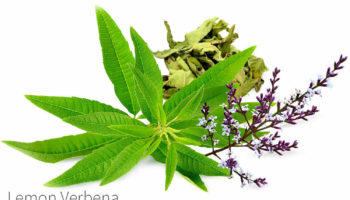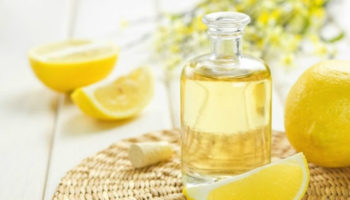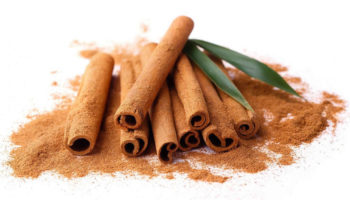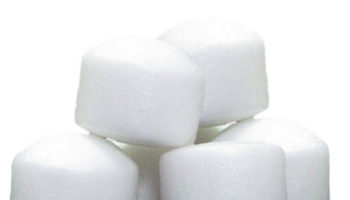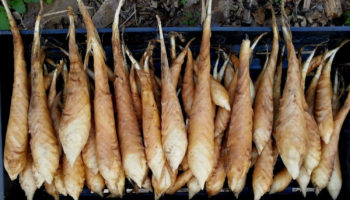What is thyme
Thyme (Thymus vulgaris) is an aromatic perennial evergreen herb of the genus Thymus of the mint family (Lamiaceae) and a relative of the oregano genus Origanum – with culinary, medicinal, and ornamental uses. The genus Thymus has numerous species of about 350 species of perennial, aromatic herb and sub shrubs native to Europe and North Africa 1. Various species of thyme is used all over the globe as condiments, ornamentals and sources of essential oil 2. The essential oil of thyme or oil of thyme, contains 20–54% thymol, is utilized as a flavor enhancer in a wide variety of foods, beverages, confectionery products and in perfumery for the scenting of soaps and lotions 3. Thyme essential oil also contains a range of additional compounds, such as p-cymene, myrcene, borneol, and linalool.
Thymol is a phenol obtained from thyme oil, is used as a stabilizer in pharmaceutic preparations. Thymol has been used for its antiseptic, bronchiolytic, antibacterial, and antifungal actions, and was formerly used as a anti-parasitic worms medicine (vermifuge) that make it popular as a medicinal herb and as a preservative for foods 4. Thymol, an antiseptic, is an active ingredient in various commercially produced mouthwashes such as Listerine 5. Before the advent of modern antibiotics, oil of thyme was used to medicate bandages. Thymol can also be found as the active ingredient in some all-natural, alcohol-free hand sanitizers.
Figure 1. Fresh thyme
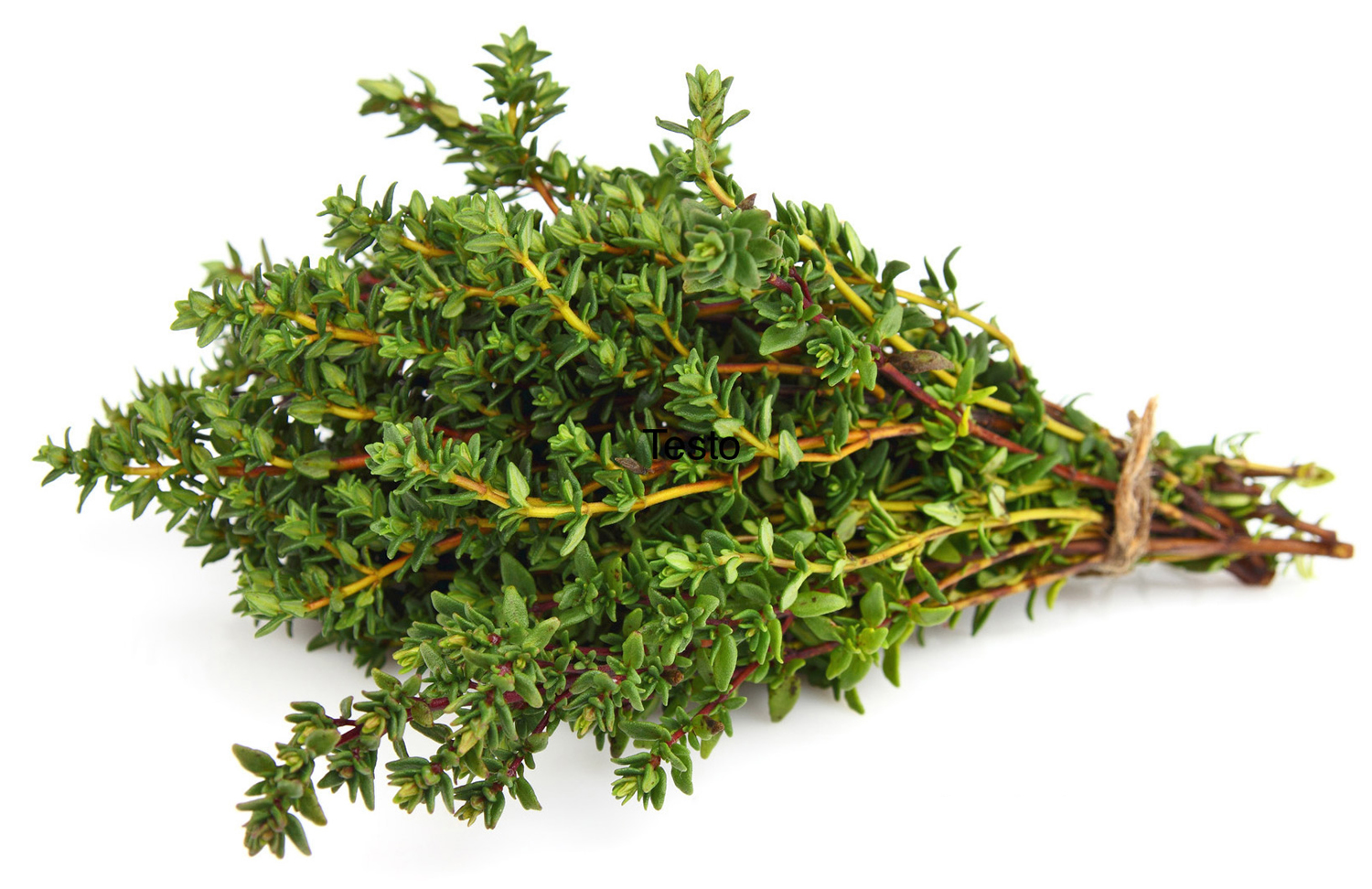
Table 1. Composition of the essential oils of Thyme (Thymus vulgaris)
| Components | Thymus vulgaris % |
| Tricyclene | – |
| α-Thujene | 1.8 |
| α-Pinene | 1.2 |
| Camphene | 0.8 |
| Sabinene | 0.6 |
| β-Pinene | 0.4 |
| β-Myrcene | 1.1 |
| 3-Octanol | – |
| α-Terpinene | 0.7 |
| p-Cymene | 19 |
| Limonene | 0.5 |
| 1,8-Cineole | 0.7 |
| cis-Ocimene | – |
| trans-Ocimene | 1.3 |
| γ-Terpinene | 4.1 |
| cis-Linalool oxide | – |
| Fenchone | – |
| α-Terpinolene | – |
| Linalool | 0.7 |
| Camphor | 0.2 |
| Menthone | – |
| Menthofuran | – |
| Borneol | 1.7 |
| Menthol | – |
| Terpin-4-ol | 1.8 |
| α-Terpineol | – |
| cis-Dihydrocarvone | – |
| trans-Ddihydrocarvone | – |
| Isodihydrocarveol | – |
| trans-Carveol | – |
| Thymol methyl ether | 0.2 |
| Neral | – |
| Carvone | – |
| Pulegone | – |
| Carvacrol methyl ether | 1.7 |
| Piperitone | – |
| Geraniol | – |
| Geranial | – |
| trans-Anethole | – |
| cis-Myrtanol | – |
| Bornyl acetate | – |
| Thymol | 48.9 |
| Menthyl acetate | – |
| Carvacrol | 3.5 |
| α-Terpinyl acetate | – |
| Geranyl acetate | – |
| β-Bourbonene | – |
| β-Elemene | – |
| trans-Myrtanol acetate | – |
| β-Caryophyllene | 3.5 |
| α-trans-Bergamotene | – |
| α-Guaiene | – |
| (Z)-β-Farnesene | – |
| α-Guaieneε | 0.3 |
| Germacrene D | 0.3 |
| Bicyclogermacrene | – |
| Germacrene A | – |
| δ-Cadinene | – |
| α-Cadinene | 2.2 |
| Spatulenol | – |
| Caryophyllene oxide | – |
| Viridiflorol | – |
| Total | 97.2 |
| – not detected | |
Note: The main components were thymol (48.9%) and p-cymene (19.0%)
[Source 6]Thyme uses
Culinary use
Thyme is sold both fresh and dried. While summer-seasonal, fresh greenhouse thyme is often available year round. The fresh form is more flavourful, but also less convenient; storage life is rarely more than a week. However, the fresh form can last many months if carefully frozen.
Fresh thyme is commonly sold in bunches of sprigs. A sprig is a single stem snipped from the plant. It is composed of a woody stem with paired leaf or flower clusters (“leaves”) spaced 1⁄2 to 1 inch (13 to 25 mm) apart. A recipe may measure thyme by the bunch (or fraction thereof), or by the sprig, or by the tablespoon or teaspoon. Dried thyme is widely used in Armenia in tisanes (called urc).
Depending on how it is used in a dish, the whole sprig may be used (e.g., in a bouquet garni), or the leaves removed and the stems discarded. Usually, when a recipe specifies “bunch” or “sprig”, it means the whole form; when it specifies spoons, it means the leaves. It is perfectly acceptable to substitute dried for whole thyme.
Leaves may be removed from stems either by scraping with the back of a knife, or by pulling through the fingers or tines of a fork.
Thyme retains its flavor on drying better than many other herbs.
Figure 2. Dried thyme
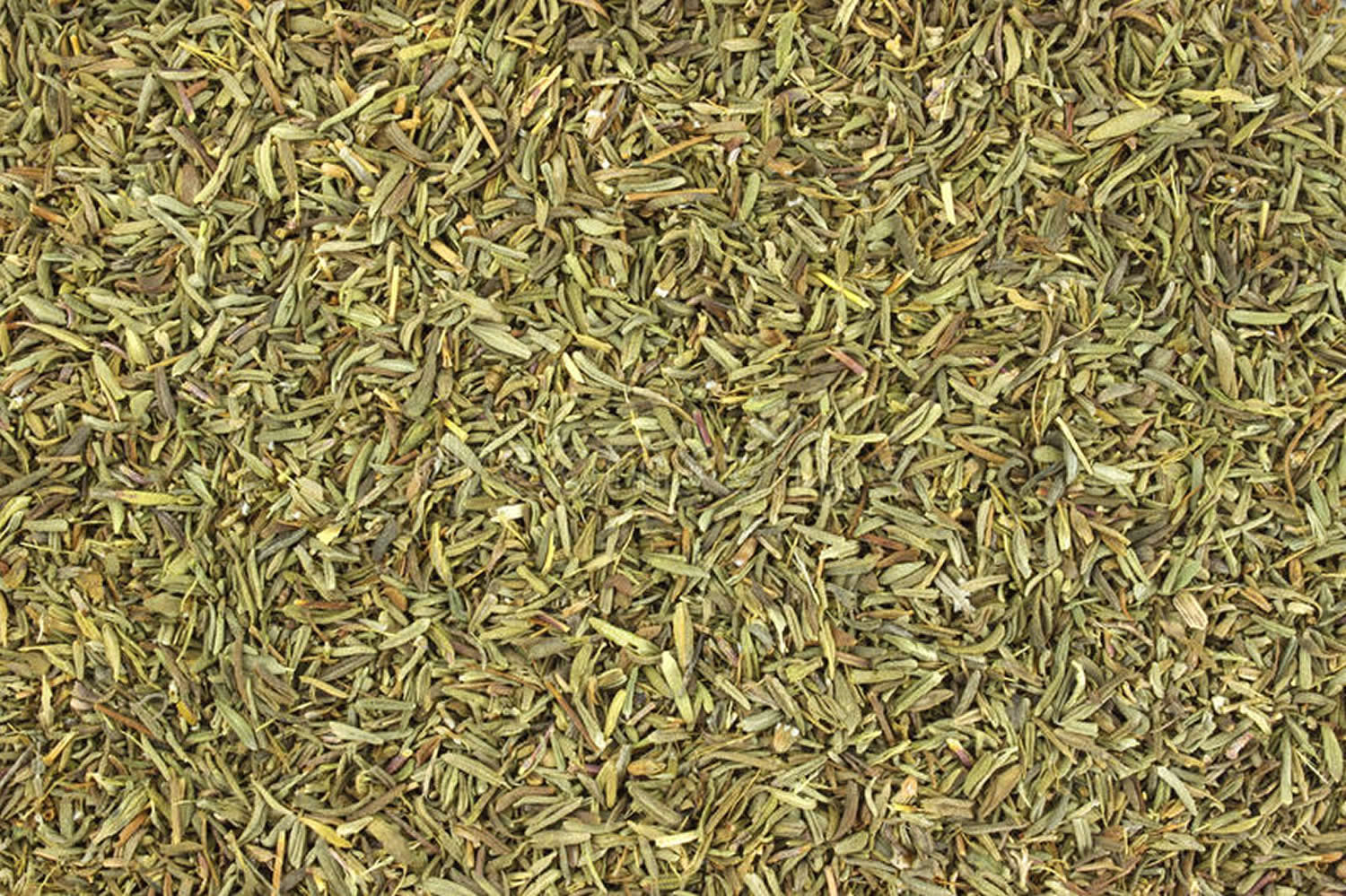
Health benefits of thyme
The therapeutic potential of thyme rests on its contents of thymol, flavonoids, carvacrol, p-cymene, β-pinene, γ-terpinene, β-caryophyllene, 1-borneol, 1,8-cineole, eugenol, aliphatic phenols as well as saponins, and tetramethoxylated flavones 7, 8, 9. Besides possession of antimicrobial action, thyme essential oil functions as phytoprotective agents, defending the plant from herbivores and lethal pathogens 10. Though the modes of action of the thyme extracts are not known, their antimicrobial agents include thymol, terpenes, eugenol, flavones, glycosides of phenolic monoterpenoids and aliphatic alcohols among other elements 11. These substances acting alone or in combination may result in a broad spectrum of antimicrobial activity exhibited for both bacteria and fungi.
Thymol is a natural compound isolated from thyme. It has antiseptic, antifungal, and strong antibacterial activities 12. It also has a powerful antioxidant activity 13. Previously published data show remarkable differences in the volatile composition of thyme in different countries. Thyme accumulates high amounts of thymol including 42.63 %, (in Pakistan), 64.6 % (in India), and 81.5 % (in Armenia) 14. Contrary to these countries, thymol and carvacrol were not detected in the thyme from Lithuania, Sweden, Finland and Poland 14.
Thyme was also found to have a significant antiparasitic effect against bird protozoan, Trichomonas gallinae 15, and in vitro scolicidal effects against Hydatid cyst 16. However in a test tube study involving thyme oil extract, it failed to kill Salmonella choleraesuis or Klebsilela pneumoniae but stopped the growth of Pseudomonas aeruginosa, Staphylococcus aureus and Candida albicans 17. In another test tube study, the essential oil of thyme, tested by macrodilution method, showed very strong antifungal activity. A concentration of 0.25 μL/mL of oil inhibited Alternaria alternata, Fusarium tricinctum, all Aspergillus species and dermatomycetes 18. Phomopsis helianthi and Cladosporium cladosporioides were inhibited at lower concentrations (0.125 μL/mL). Strong antifungal activity of thymol and carvacrol were also reported in the literature 19. Comparing the previous data with the chemical composition of thyme oils, it becomes evident that there is a relationship between the high activity of the thyme type oils and the presence of phenol components, such as thymol and carvacrol. The high antifungal activity of these essential oils could be explained by the high percentage of phenol components. It seems possible that phenol components may interfere with cell wall enzymes like chitin synthase/chitinase as well as with the α- and β- glucanases of the fungus 20. Consequently, the high content of phenol components may account for the high antifungal activity of thyme essential oils 21. However, the reason why yeast is more susceptible to the thyme oil extracts than bacteria is unclear but it may be that at any given time, these oils may break up the structural integrity of Candida albicans faster than they dissociate bacteria 17.
Taken together, these results suggest that thyme essential oil could find practical application in the prevention and protection of fungal infections of plants, animals and humans. Thyme essential oils could safely be used as preservative materials on foods for protection to fungal infection, since they are natural, and mostly non-toxic to humans. Furthermore, thyme is popular culinary herb and thyme essential oil has been used extensively for many years in food products, perfumery, and dental and oral products.
- Chemical composition of essential oils of Thymus and Mentha species and their antifungal activities. Soković MD, Vukojević J, Marin PD, Brkić DD, Vajs V, van Griensven LJ. Molecules. 2009 Jan 7; 14(1):238-49. https://www.ncbi.nlm.nih.gov/pubmed/19136911/[↩]
- Sthal-Biskup E, Saez F. Thyme: the genus Thymus (Medicinal and Aromatic Plants-Industrial Profiles) J Essent Oil Res. 2002;330:415–848.[↩]
- Antimicrobial activity of spices. Arora DS, Kaur J. Int J Antimicrob Agents. 1999 Aug; 12(3):257-62. https://www.ncbi.nlm.nih.gov/pubmed/10461845/[↩]
- In-vitro antimicrobial activity and chemical composition of Sardinian Thymus essential oils. Cosentino S, Tuberoso CI, Pisano B, Satta M, Mascia V, Arzedi E, Palmas F. Lett Appl Microbiol. 1999 Aug; 29(2):130-5. https://www.ncbi.nlm.nih.gov/pubmed/10499301/[↩]
- https://www.listerine.com/active-ingredients[↩]
- Chemical Composition of Essential Oils of Thymus and Mentha Species and Their Antifungal Activities. Molecules 2009, 14(1), 238-249; doi:10.3390/molecules14010238[↩]
- Safaei-Ghomi J, Ebrahimabadi AH, Djafari-Bidgoli Z, Batooli H. GC/MS analysis and in vitro antioxidant activity of essential oil and methanol extracts of Thymus caramanicus Jalas and its main constituent carvacrol. Food Chem. 2009;115:1524–1528. doi: 10.1016/j.foodchem.2009.01.051.[↩]
- Antimicrobial agents from plants: antibacterial activity of plant volatile oils. Dorman HJ, Deans SG. J Appl Microbiol. 2000 Feb; 88(2):308-16. https://www.ncbi.nlm.nih.gov/pubmed/10736000/[↩]
- Deans SG, Ritchie GA. Antimicrobial properties of plant essential oils. Int J Food Microbiol. 1987;5:165–180.[↩]
- Pharmacological and chemical investigation of thyme liquid extracts. Van den Broucke CO, Lemli JA. Planta Med. 1981 Feb; 41(2):129-35.[↩]
- Antimicrobial activity of essential oils and other plant extracts. Hammer KA, Carson CF, Riley TV. J Appl Microbiol. 1999 Jun; 86(6):985-90. https://www.ncbi.nlm.nih.gov/pubmed/10438227/[↩]
- Mathela CS. Singh KK. Gupta VK. Synthesis and in vitro antibacterial activity of thymol and carvacrol derivatives. Acta Pol Pharm. 2010;67:375–380.[↩]
- Ahmad A, Khan A, Yousuf S, Khan LA, Manzoor N. Proton translocating ATPase mediated fungicidal activity of eugenol and thymol. Fitoterapia. 2010;81:1157–1162.[↩]
- Loziene K, Venskutonis PR. Chemical composition of the essential oil of Thymus serpyllum L. ssp. serpyllum growing wild in Lithuania. J Essent Oil Res. 2006;18:206–211. doi: 10.1080/10412905.2006.9699067.[↩][↩]
- Nasrabadi NT, Mirghasemi N, Bakhtiari N, Zarrinkoub N, Mirghasemi N. Comparison of anti-parasitic effects of garden thyme (Thymus vulgaris) extract and metronidazole on Trichomonas gallinae. RPS. 2012;7,Suppl.[↩]
- Moazeni M, Saharkhiz MJ, Hosseini AA. In vitro lethal effect of a jowan (Trachysperm umammi L.) essential oil on hydatid cyst protoscoleces. Vet Parasitol. 2012;187:203–208.[↩]
- Nzeako BC, Al-Kharousi ZSN, Al-Mahrooqui Z. Antimicrobial Activities of Clove and Thyme Extracts. Sultan Qaboos University Medical Journal. 2006;6(1):33-39. https://www.ncbi.nlm.nih.gov/pmc/articles/PMC3074903/[↩][↩]
- Chemical Composition of Essential Oils of Thymus and Mentha Species and Their Antifungal Activities. Molecules 2009, 14(1), 238-249; doi:10.3390/molecules14010238 http://www.mdpi.com/1420-3049/14/1/238/htm[↩]
- Lawless, J. The encyclopedia of essential oils; Thorsons: London, UK, 2002; pp. 115–117.[↩]
- Adams, S.; Kunz, B.; Weidenbörner, M. Mycelial deformations of Cladosporium herbarum due to the application of Eugenol and Carvacrol. J. Essent. Oil Res. 1996, 8, 535–540.[↩]
- Adam, K.; Sivropoulou, A.; Kokkini, S.; Lanaras, T.; Arsenakis, M. Antifungal activities of Origanum vulgare subsp. hirtum, Mentha spicata, Lavandula angustifolia and Salvia fruticosa essential oils against human pathogenic fungi. J. Agric. Food Chem. 1998, 46, 1738–1745.[↩]
